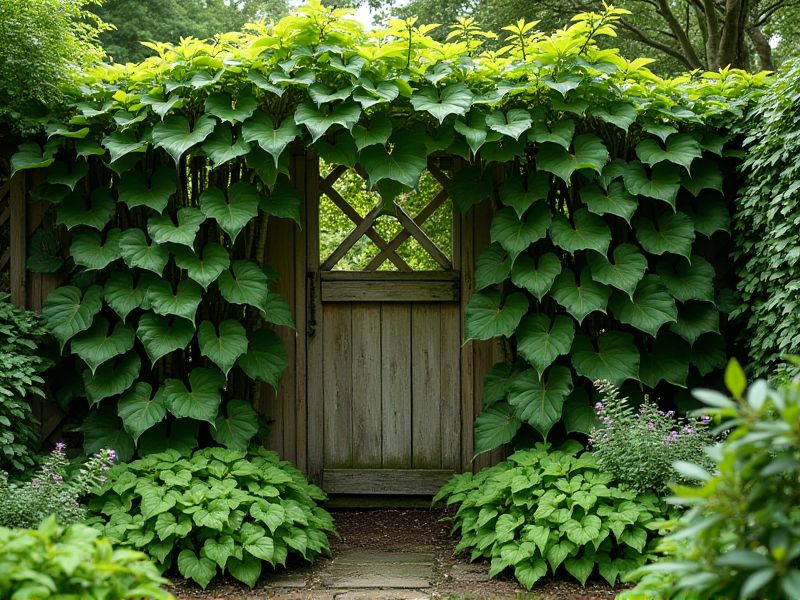
Climbing plants, such as clematis, wisteria, and honeysuckle, thrive when supported by trellises, which provide essential vertical space for growth. These structures can be made from wood, metal, or plastic, offering durability and aesthetic appeal to your garden. Proper placement of the trellis enhances sunlight exposure and airflow, contributing to the health and vibrancy of the climbing plants. When choosing a trellis, consider the mature size and weight of the plant, ensuring it can adequately support your chosen species. Regular maintenance, such as pruning and tying, is necessary to encourage fuller growth and prevent damage.
List of some Climbing plants that require trellises
- Clematis (Clematis spp.)
- Sweet Pea (Lathyrus odoratus)
- Morning Glory (Ipomoea tricolor)
- Honeysuckle (Lonicera spp.)
- Passionflower (Passiflora spp.)
- Wisteria (Wisteria spp.)
- Bougainvillea (Bougainvillea spp.)
- Trumpet Vine (Campsis radicans)
- Black-eyed Susan Vine (Thunbergia alata)
- Jasmine (Jasminum spp.)
Important things about Climbing plants that require trellises
Support Structure Necessity
Climbing plants, such as clematis and pole beans, thrive with the support of trellises that provide essential vertical growth space. These structures enhance air circulation around the foliage, reducing the risk of fungal diseases while maximizing sunlight exposure for photosynthesis. Utilizing a robust trellis design not only supports the weight of the climbing plants but also contributes to a decorative element in your garden. Properly selected materials, such as wood or metal, ensure durability and longevity for a sustainable gardening solution.
Growth Habits
Climbing plants, such as peas, beans, and various vine flowers, thrive when supported by trellises, enhancing their growth potential and maximizing space in your garden. These structures allow the plants to reach sunlight more effectively, promote air circulation, and minimize disease risk by keeping foliage off the ground. Materials like wood, metal, or even biodegradable options can be used to create sturdy trellises tailored for specific plant needs. Incorporating climbing plants with trellises not only adds vertical interest to your landscape but also contributes to a productive and flourishing garden environment.
Plant Selection
Climbing plants that thrive on trellises add vertical interest to your garden while maximizing space. Varieties such as honeysuckle, clematis, and climbing roses are ideal choices, offering vibrant blooms and fragrant foliage. To ensure robust growth, select a sturdy trellis made of wood, metal, or a decorative lattice that complements your outdoor aesthetics. When planting, consider the sun exposure and moisture requirements of your chosen climbers to promote optimal health and flourishing displays.
Light Requirements
Climbing plants that require trellises thrive in environments with ample sunlight, making light exposure a crucial factor for their growth and flowering. Most climbing varieties, such as passionflower and clematis, prefer full sun to partial shade, ideally receiving at least six hours of direct sunlight daily. Proper light conditions enable these plants to climb and spread effectively, enhancing both their beauty and vigor. To ensure your climbing plants flourish, position their trellises in locations that maximize sunlight and support their upward growth.
Soil Conditions
Climbing plants, such as grapevines and morning glories, thrive in well-draining soil enriched with organic matter, which enhances nutrient availability. The ideal pH level for these plants typically ranges from 6.0 to 7.0, promoting optimal root development and health. Ensure your trellis is positioned in an area that receives ample sunlight, as most climbing varieties flourish in bright conditions, leading to robust growth. Regular soil moisture monitoring is essential, as both overwatering and drought can significantly hinder their climbing ability and overall vigor.
Watering Needs
Climbing plants that require trellises, such as clematis and climbing roses, typically need consistent moisture for optimal growth. These plants thrive in well-drained soil, so ensure your watering technique promotes moisture retention without waterlogging their roots. During hot summer months, you may need to water these plants deeply at least once a week, while monitoring the topsoil for dryness. Implementing a drip irrigation system or soaker hose can provide efficient moisture delivery, benefitting both your climbing plants and the trellis structure supporting them.
Fertilization Practices
Climbing plants, such as peas, beans, and cucumbers, thrive when supported by trellises, which enhance air circulation and maximize sunlight exposure. Proper fertilization plays a crucial role in their growth; organic fertilizers like compost or well-rotted manure enrich the soil, providing essential nutrients. Regularly monitoring soil pH helps ensure that nutrient uptake remains optimal, making the plants more resilient to pests and diseases. For best results, apply a balanced fertilizer during the active growing season to support your climbing plants on their trellis.
Pruning Techniques
Pruning climbing plants that require trellises is essential for ensuring healthy growth and maximizing blooming potential. Regularly removing dead or overcrowded stems helps to improve air circulation and sunlight penetration, promoting a robust and vibrant plant structure. Techniques such as thinning, cutting back, and shaping can be tailored to specific varieties like clematis, climbing roses, or wisteria, each requiring different approaches for optimal results. By employing these methods, you can maintain the aesthetic appeal of your trellis while encouraging lush foliage and an abundant floral display.
Pest Management
Climbing plants, such as peas, tomatoes, and clematis, often thrive when supported by trellises, which enhance air circulation and sunlight exposure. Implementing integrated pest management (IPM) strategies is essential for protecting these plants from common pests like aphids and whiteflies. Regular monitoring, combined with the use of natural predators like ladybugs, can effectively reduce pest populations without harmful chemicals. Creating a diverse garden environment can also attract beneficial insects, further ensuring your climbing plants remain healthy and productive.
Seasonal Care
Climbing plants such as clematis, wisteria, and jasmine thrive when supported by trellises, maximizing their vertical growth and aesthetic appeal. Proper seasonal care includes pruning after flowering to encourage new growth while preventing overcrowding on the trellis, ensuring healthy airflow. Regular watering during dry spells and organic fertilization in spring promote lush foliage and vibrant blooms. To enhance your garden's design, select trellis materials that complement your climbing plants' characteristics, creating a harmonious landscape.
